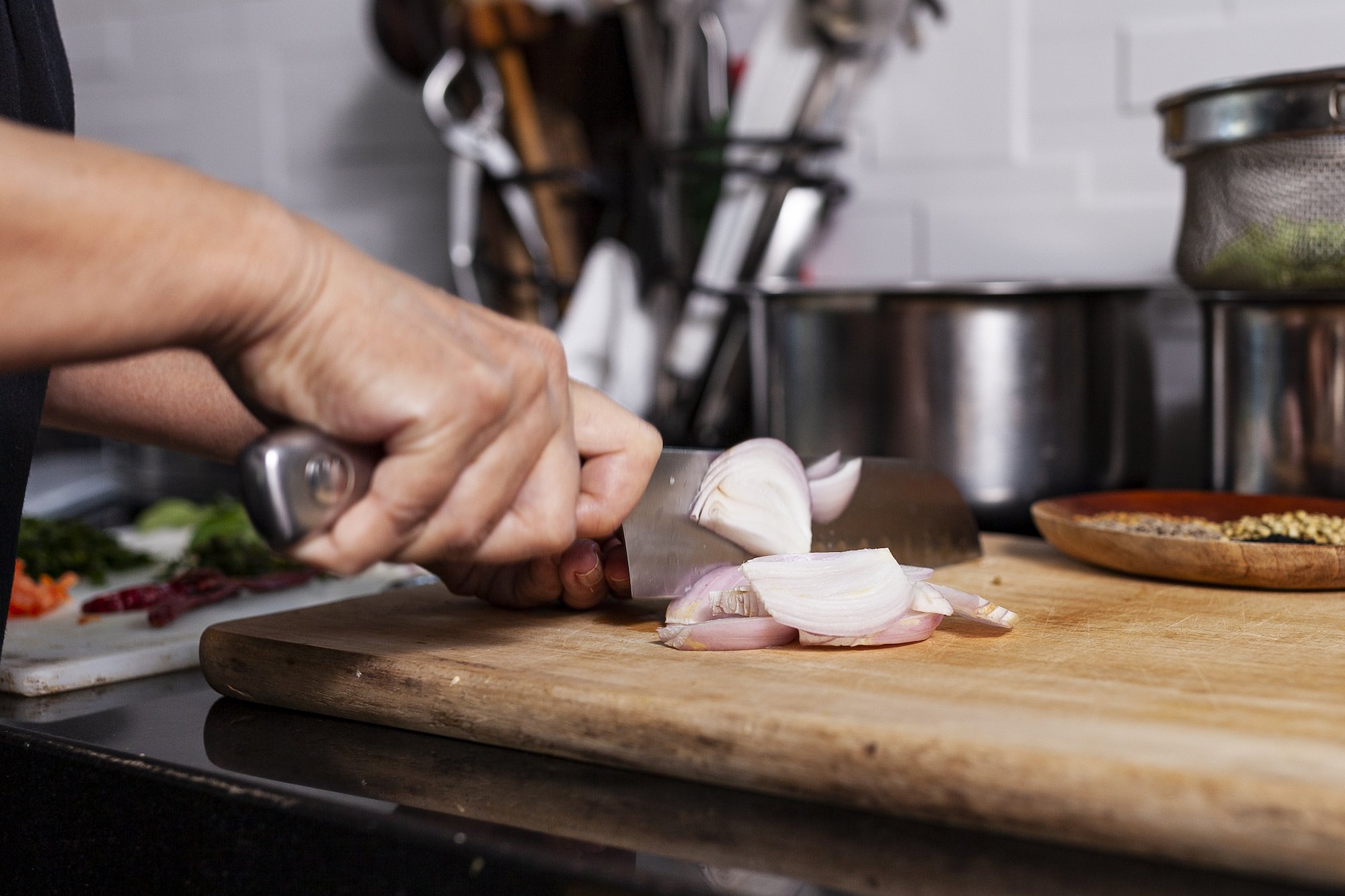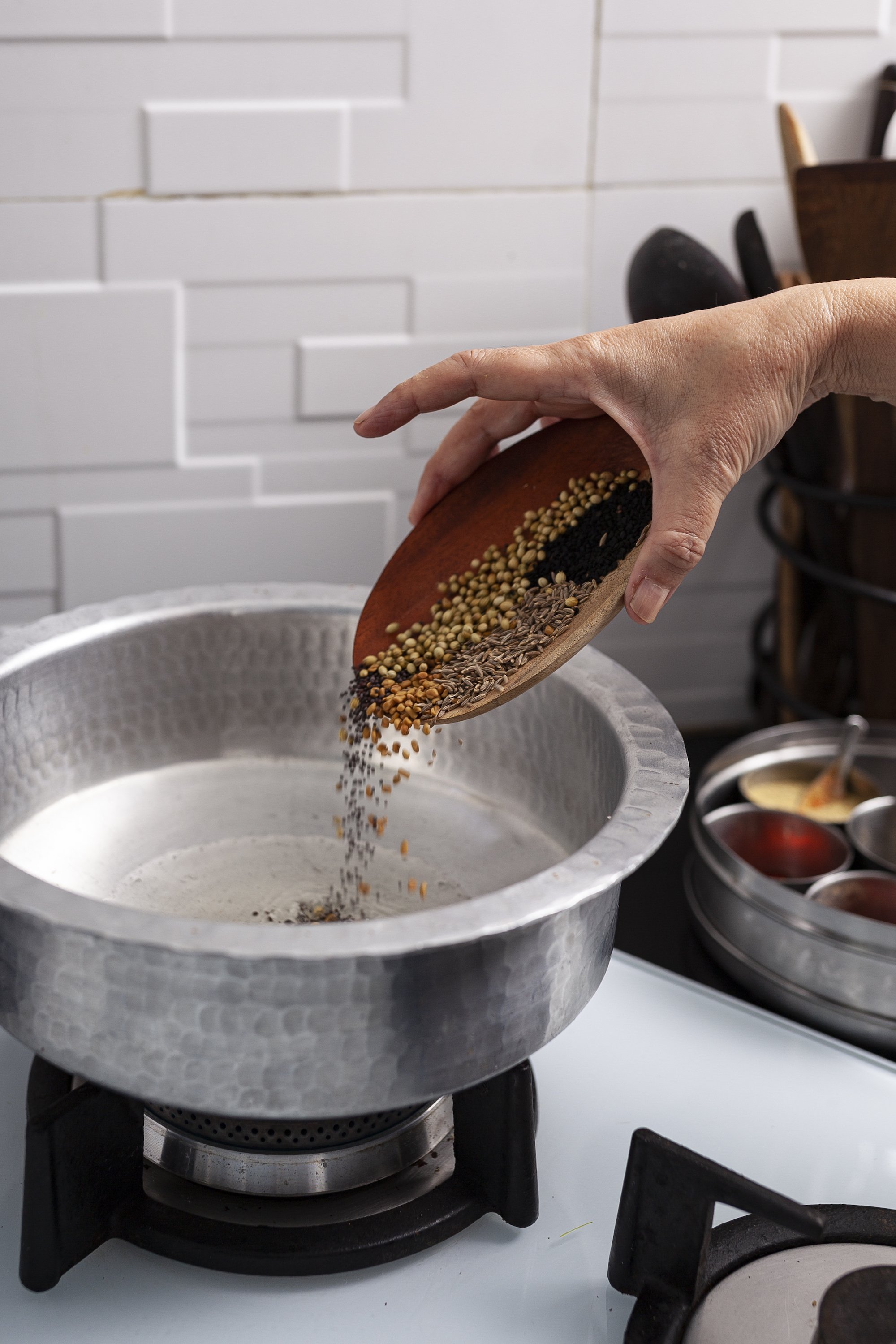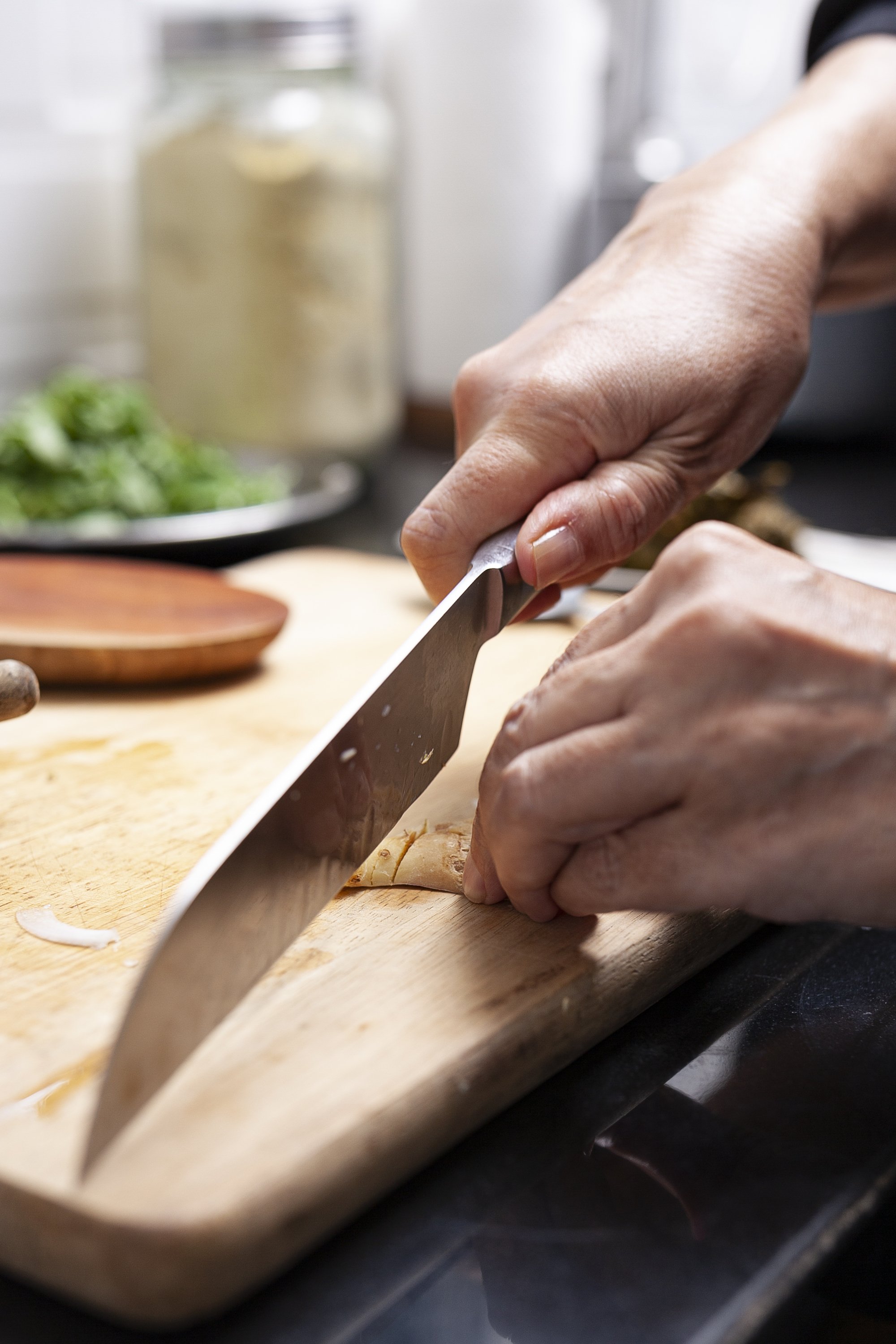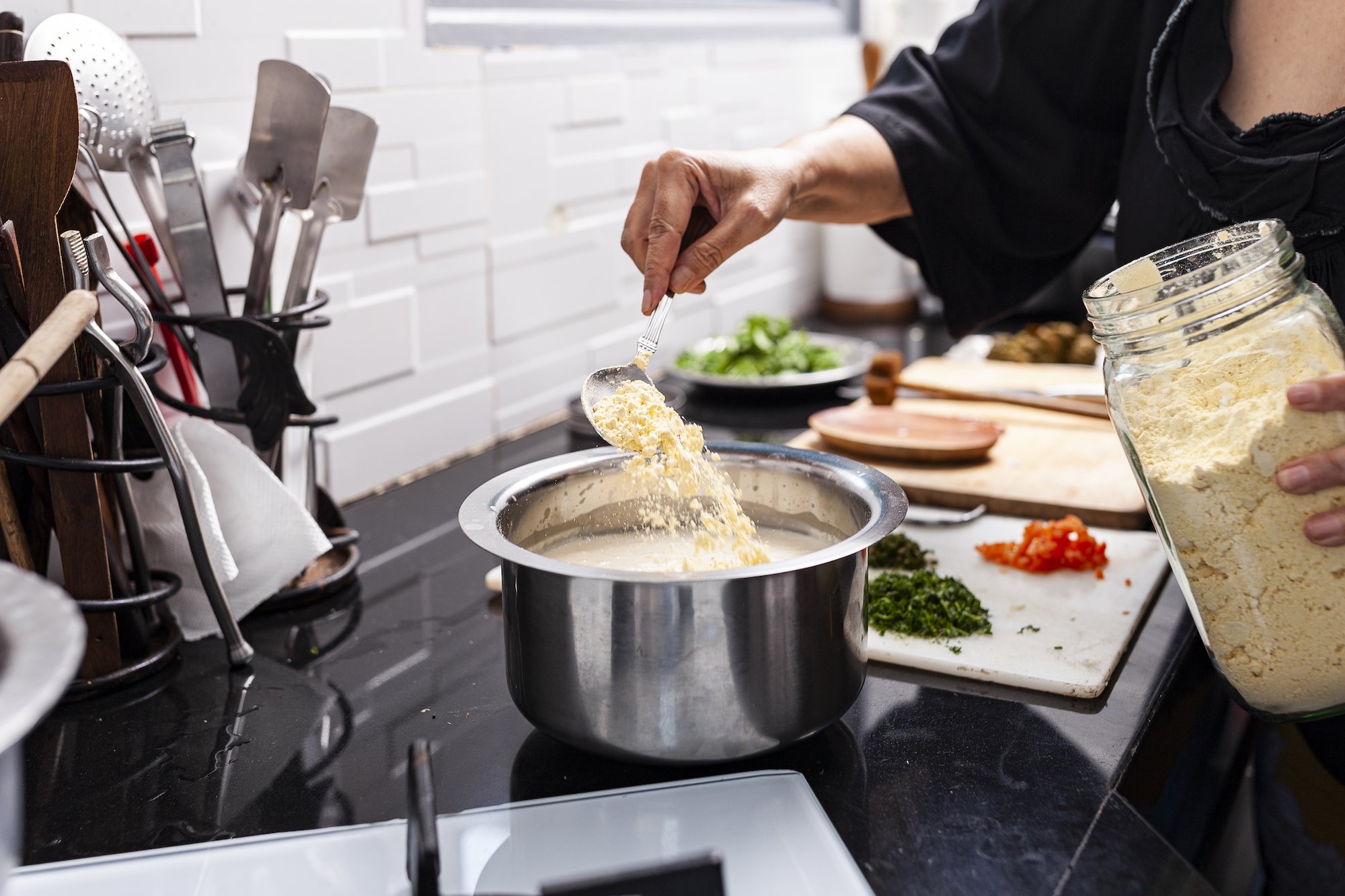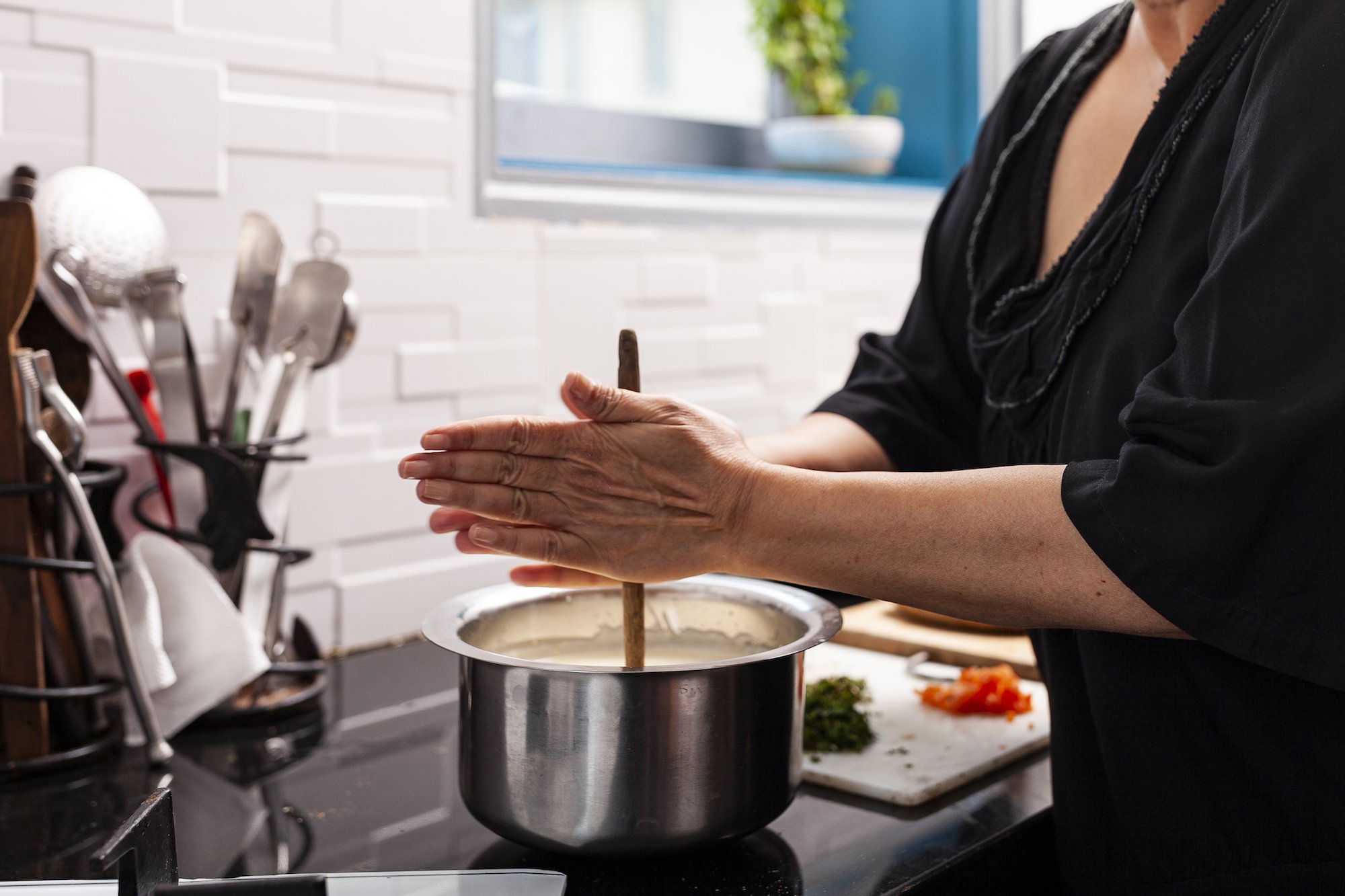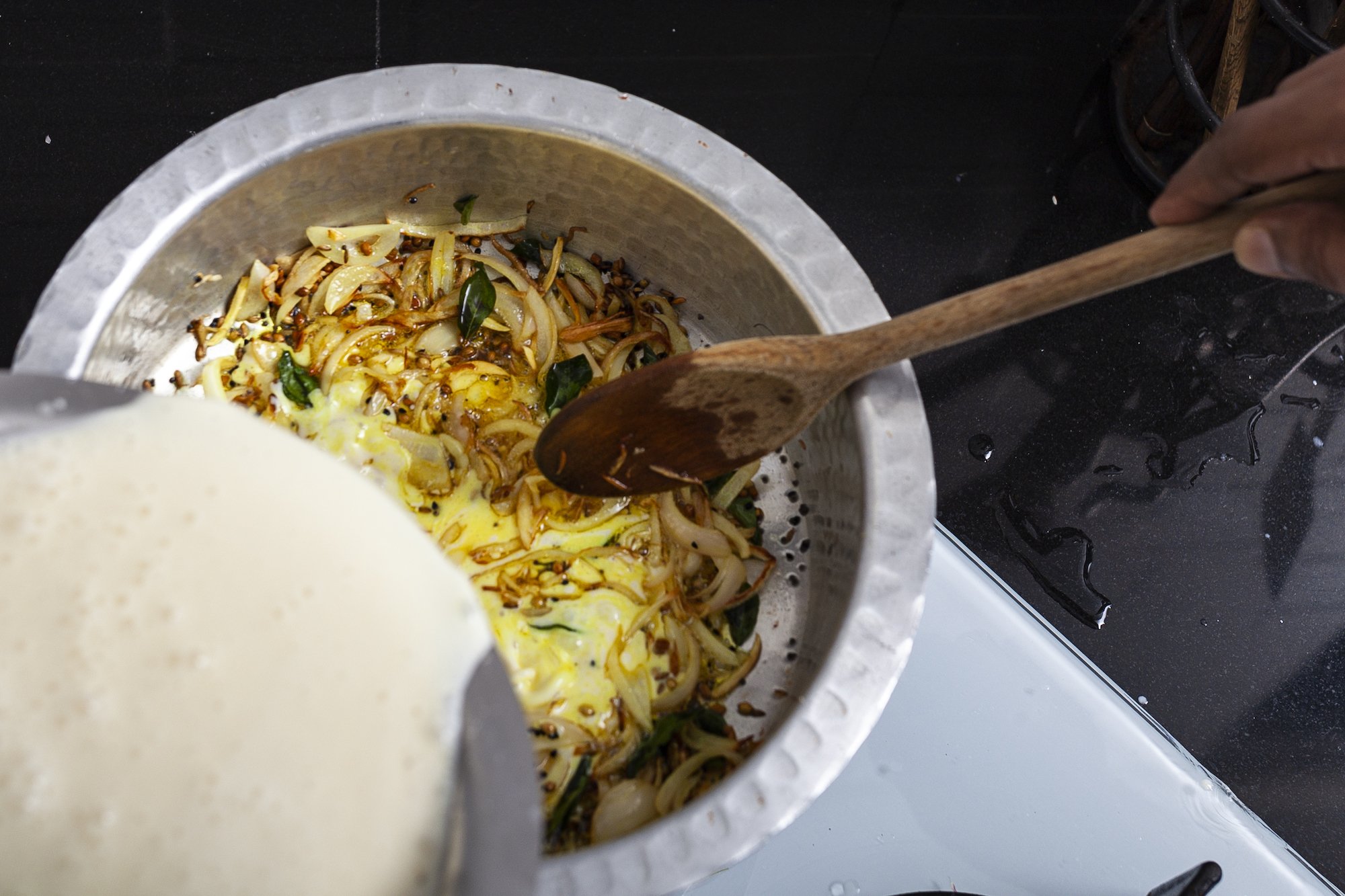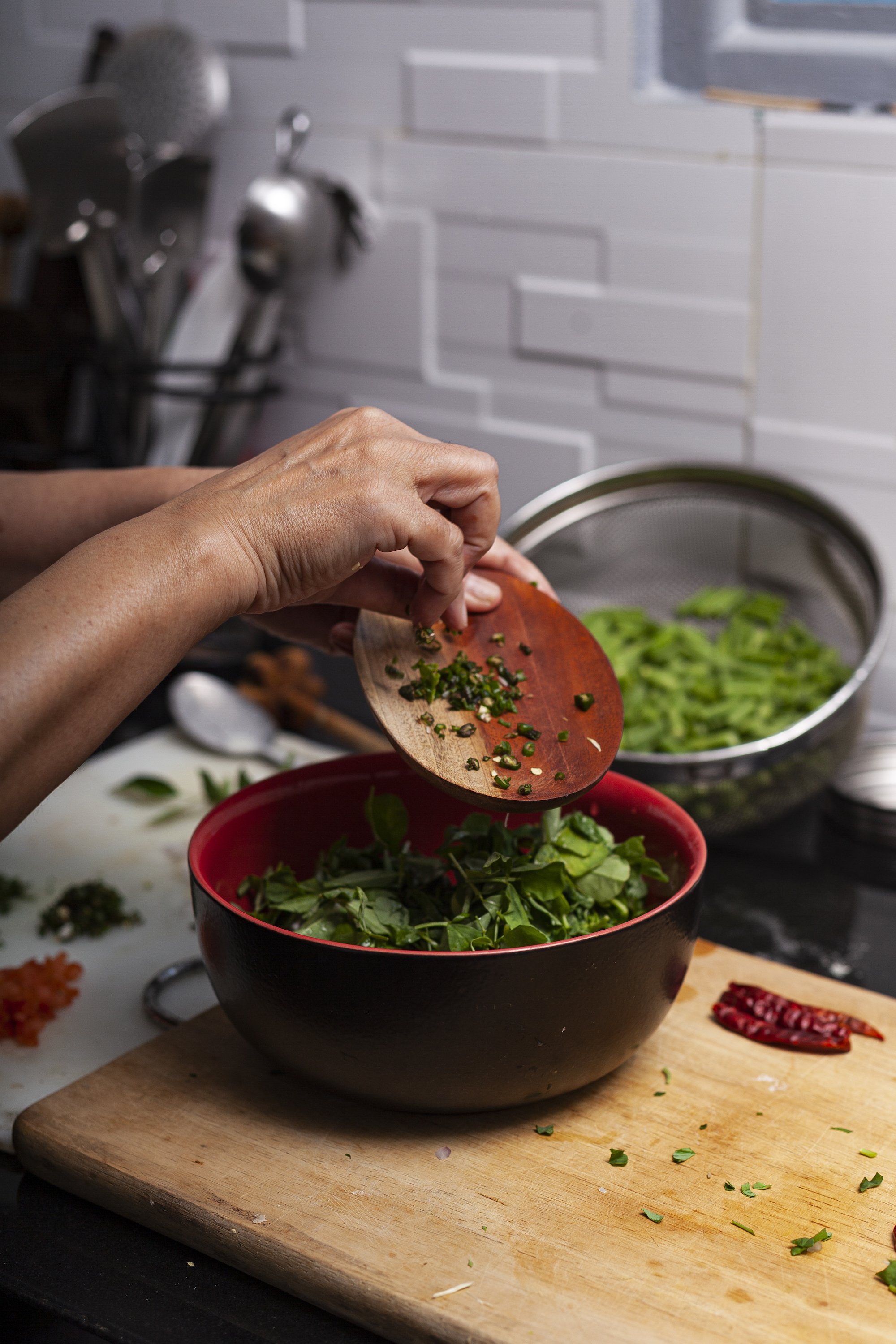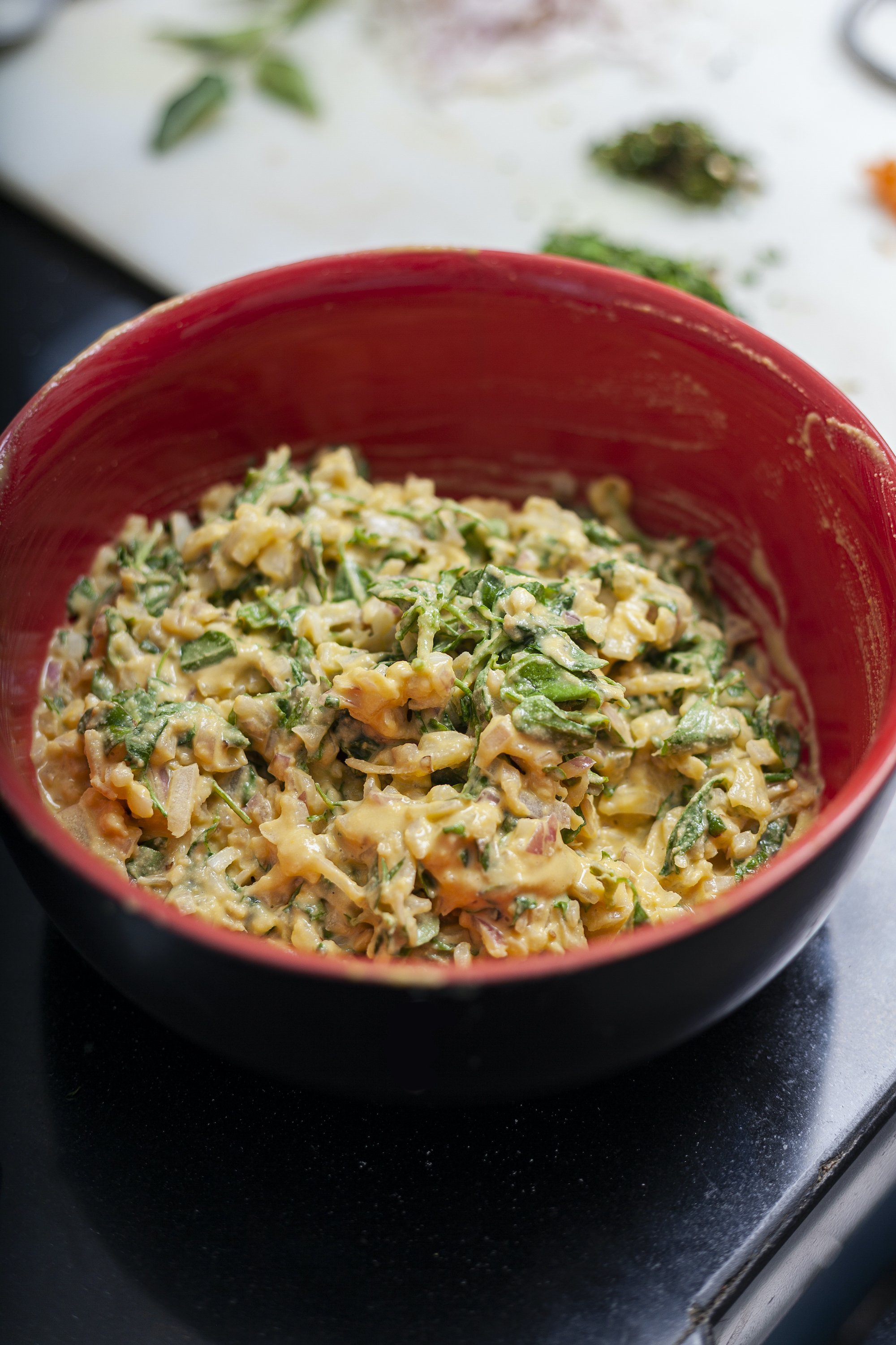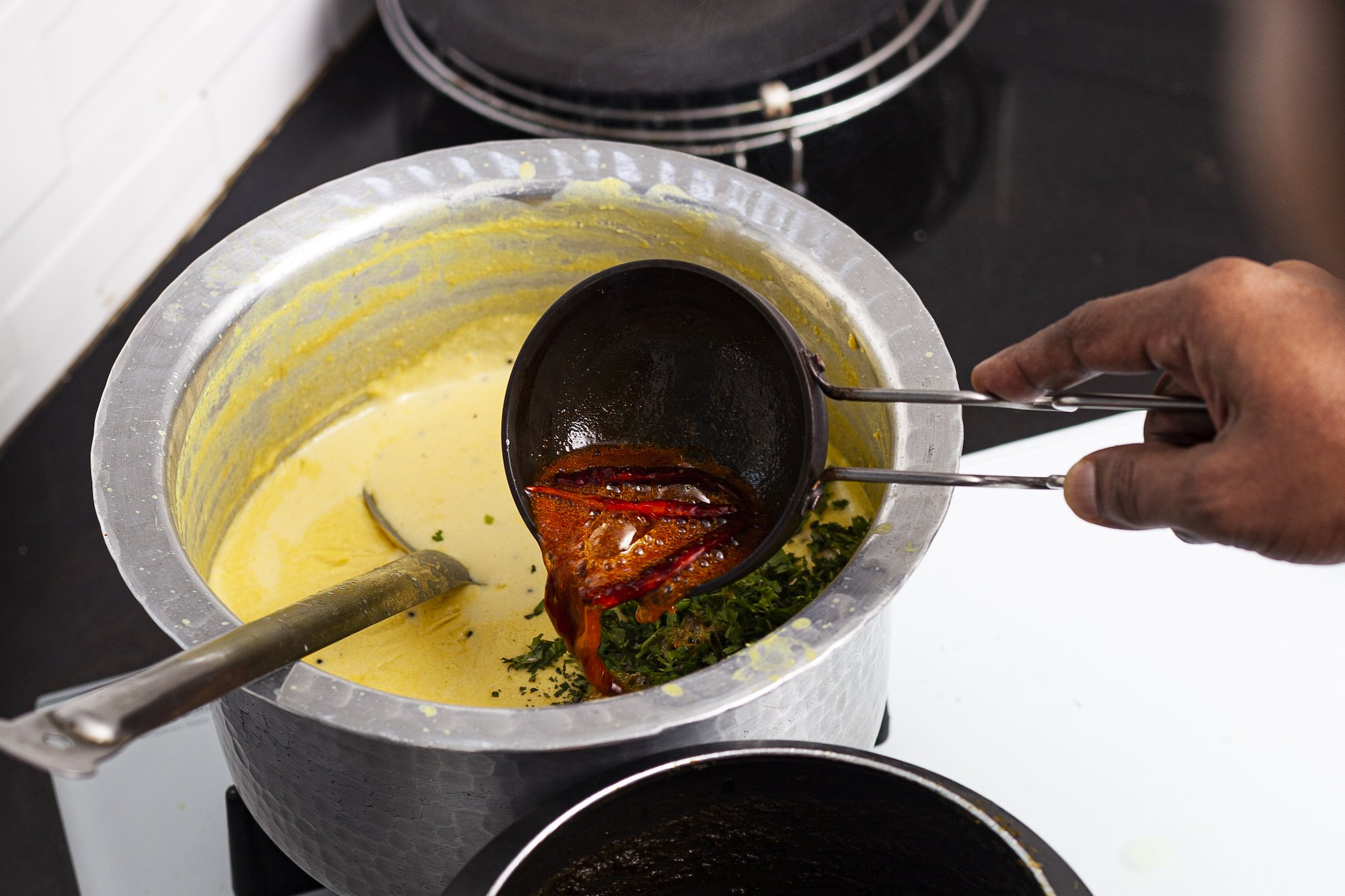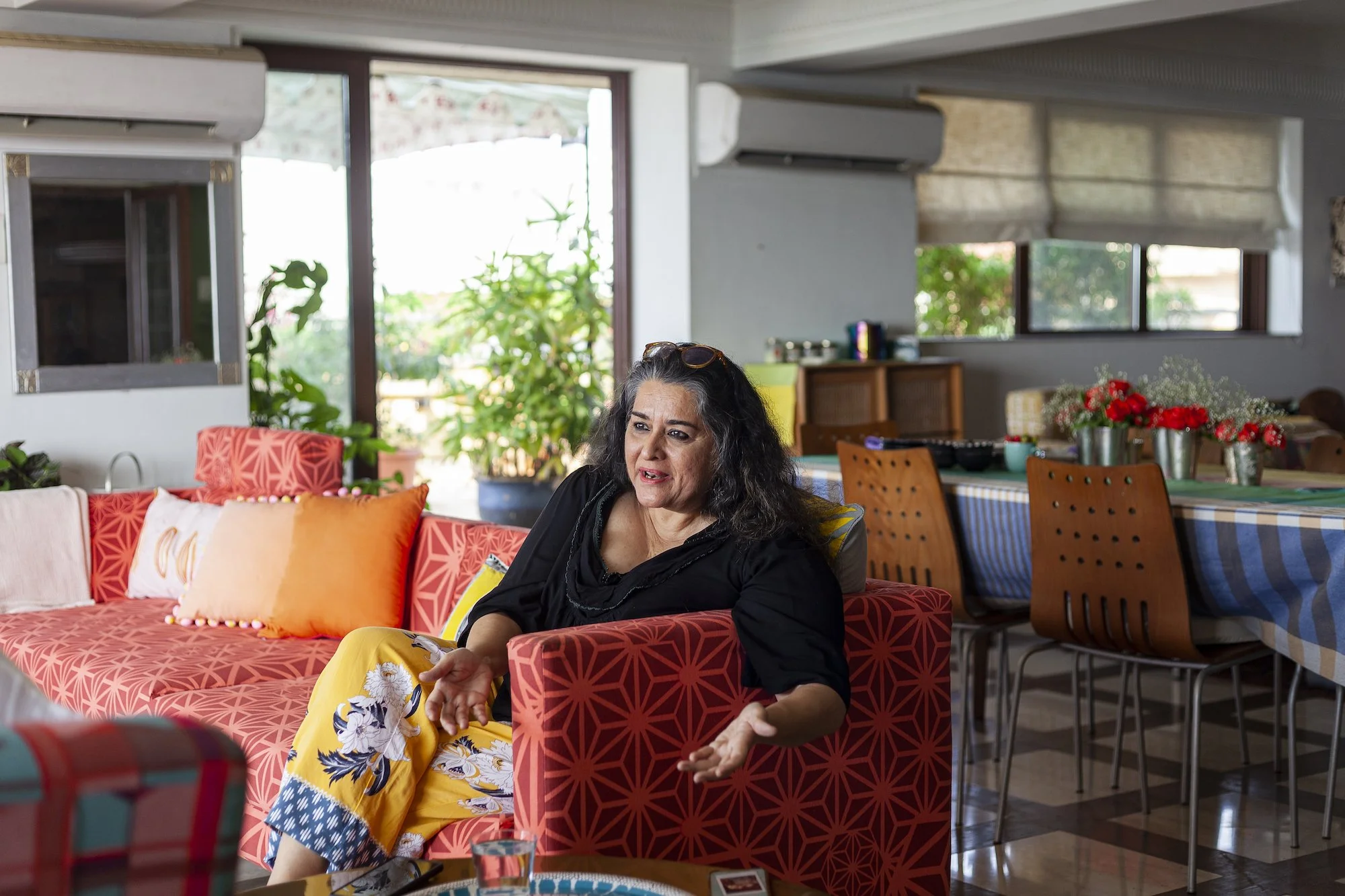Latika Khosla Cooks Home-Style Punjabi Kadhi

#1000Kitchens is a series that goes into kitchens all over the country, documenting heirloom recipes that tell a story. In this edition, Laktika Khosla, founder of Freedom Tree, cooks a home-style Punjabi kadhi in her Mumbai home.
It is early November in Bombay, and Latika Khosla sits in a living room bathed in sunlight. The afternoon light washes over her, spilling across the dining table touching the warm browns of a bookcase on the far wall. Outside the window, the late afternoon sun reflects sharply over the Arabian Sea and she draws the curtains to soften the light. Her home is peppered with playful mid-century modern pieces in the unmistakable voice of Freedom Tree – its prints and colours married by effortless grace.
Latika leads us through the house. The table is laid with glasses of nimbu pani (cold and refreshing, with unexpected depth), a platter of fruit drizzled with chilli and honey (inspired by Indonesian rujak) and bowls of masala peanuts. “It’s a galley kitchen in here,” she warns. A meal plan is tacked to the fridge and the kitchen smells like freshly chopped coriander.
Latika Khosla is most well-known as the founder of Freedom Tree, a modern home store that pioneers linens, fabrics, and serve-ware with a design sensibility that boldly embraces colour, pattern, and prints. Latika’s background in design and colour carried her to the furthest corners of an emerging global culture, absorbing tradition, landscape, and ritual, to map and predict trends around the world. Both her home and Freedom Tree are an expression of those years. Comfort and joy reign supreme.
Today she is cooking kadhi, a recipe that pays tribute to her Punjabi roots. “It is a very simple recipe, that much ado is made of in Punjabi homes,” she reveals, smiling. "It’s the kind of dish you leave on the stove for half an hour, stir occasionally, and go out to water the garden. Unfussy and delicious.” We suspect this may have more to do with her personal style than kadhi.
A Business Woman, Mother, and Quick Cook
Latika calls herself a quick cook. Travelling 20 days a month on work didn’t leave her with much time to cook for the family. “I decided I’d learn 2 or 3 dishes and do them well.” She turns the translucent pages of her mother’s recipe book – a collection of recipes borrowed from friends through their years in the railways – Mrs Ibrahim’s biryani, and Mrs S’s achar, a 7-minute white chocolate pudding. Latika’s culinary style is partially inherited, and partially her own – quick, thoughtful, elegant.
Her style transitions effortlessly from living room to kitchen. She pulls her hair into a bun, rests her glasses on the windowsill and gets down to business. “We use 4 dry ingredients, and 5 wet ingredients. That’s how I remember it,” she says, slicing through an onion to toss into a pot on the stove. They soften, turning a light shade of pink, and then bright yellow with the addition of turmeric. She moves to a big bunch of methi greens, tearing them roughly into a bowl of besan. “I love kheerai in my pakodas. I often add any leftover veggies from the fridge too.”
She calls this the ultimate phase of life: rather than ask for recipes, friends call to say — ‘We’re coming over, please make us your stew.’ People are nervous about serving home-style food. But I’ve come to find that they just want to spend time with each other, let their guard down, hunker over a table and eat something familiar.”
The Artist’s Eye
She carries a bowl to the dining table, gently ladling spiced yogurt gravy over the pakodas. “I always like to make an extra batch of pakodas to freeze. In fact, this entire kitchen runs on freezing,” she laughs. She moves a tumbler of bright orange roses, and pauses over a rug by the tv. “Everyone asked why I bought a crooked rug,” she laughs. “But if you look closer…” Between traditional motifs of vases and birds on the maroon hand-stitched rug, are the unmistakable images of a tank, jeeps, and helicopters. “The artisans draw what they see. And for two decades, the Afghans have only seen war.”
Latika’s home represents a journey guided by curiosity, bringing together the artist’s sharp eye and a kindness of spirit. Her travels through Asia, Europe — and India — changed her perspective on the rules of engagement. “I don’t buy art as investment. I buy art to live with joy. As a host, I learned to let go. The only important thing is people, not matching cutlery. In fact, I am not embarrassed even if I run out of food. I’ll just make you a 16-egg burji.”
Before we leave, she shares the secret to her nimbu pani: lime juice made with pink salt, black pepper, chaat masala, and sugar. Served not-too-cold, with a sprig of fresh mint.
LATIKA’S RECIPE FOR HOME-STYLE PUNJABI KADHI
Ingredients for Kadhi
1 tsp cumin seeds
1 tsp fenugreek seeds
2 tsp coriander seeds
1 tsp mustard seeds
1 large onions, sliced
2 cloves garlic, chopped
1 inch ginger, chopped
2 green chillies, chopped
2 sprigs curry leaves
8 tbsp besan
1.5 cups of yogurt
3 cups water
1/2 tsp turmeric
1/2 tsp red chilli powder
Salt, to taste
2 tsp kasoori methi
Handful of fresh coriander
Method
In a pot, heat ghee, and add in the cumin, fenugreek, coriander seeds and mustard.
Once toasted and aromatic, add in the onion and fry until softened.
Add in the ginger, garlic and green chilli and curry leaves.
In another container, combine besan, yogurt, water, turmeric, red chilli powder and salt. Whisk to a smooth mix.
Pour the yogurt mix into the pot, and allow to cook. Bring to a boil then reduce to a simmer.
Allow to cook for 30 minutes, stirring regularly to prevent catching at the bottom. The kadhi will thicken.
Finish with kasoori methi and fresh coriander leaves.
To make pakoras
2 onion, chopped
1 inch ginger
1 bunch methi leaves, roughly torn
1 tsp green chillies
Hing, a pinch
Rock salt, to taste
4 ladles of besan
Ajwain, a pinch
1 tsp baking soda
Method
Combine the ingredients for the pakodas with a few tablespoons of water, to make a thick batter.
Drop into hot oil and fry until golden.
(Can make a large batch and freeze to use later).
Add the pakodas into the kadhi just before serving, and finish with a tadka.
Ingredients for tadka
2 tbsp ghee
1 tsp mustard seeds
Hing, a pinch
3 Dry red chillies
1 tsp red chilli powder
Method
In a small pan, heat ghee and add in the mustard seeds.
When they sputter, add in the hing, dry red chillies and chilli powder.
Pour over the kadhi and pakodas.
Words by Anisha Rachel Oommen. Photos by Nachiket Pimprikar.
ALSO ON THE GOYA JOURNAL



